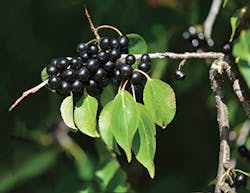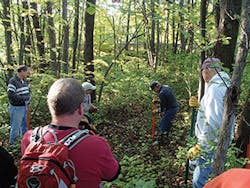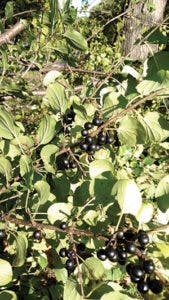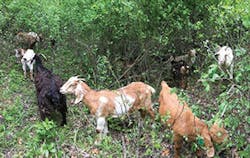The Twin Cities Versus the Invaders from Planet Earth
When William Shakespeare introduced the starling into his play Henry IV more than 400 years ago, he recognized the bird’s moderately annoying qualities by imagining it tormenting its host with the repetition of a single utterance—over and over and over. However, he certainly could have had no concept that his words would trigger the dramatic invasion of an entire continent centuries later, much to the annoyance of a much broader population. Drawing inspiration from the voluminous works of his idol, Eugene Schieffelin—a history buff, Zoological Society member, and member of the American Acclimatization Society—sauntered into Central Park in New York City one day in 1890 to release several dozen European starlings into the sooty skies in an attempt to fulfill his dream that North America, for good or for ill, would have all of the birds mentioned in the great playwright’s works.
Since the concept of invasive species had not yet emerged in science, Schieffelin and fellow members of the Acclimatization Society—whose goal was to introduce European species into North America—could never have guessed what would eventually happen. Encountering no natural enemies, and finding a vibrant ecological niche of recently deforested meadows left bare by the predation of timber barons and emergent large-scale farming schemes, the starlings proliferated to become the bane of birdwatchers and naturalists, filling the air with their screeches and squawks and driving away the native birds. To date, the population of the pestilent, speckled avians has exploded from those few dozen to 200,000,000 in North America. The descendants of Schieffelin’s generous gesture now account for one-third of the European starling’s worldwide population.
The starling is but one of the many stories of invasive species. In fact, invasions have proliferated through both intentional and accidental introductions of various species of plants and animals throughout the world. Most cases are less dramatic than the Schieffelin scenario, but to those who care about ecosystem health, they have been no less annoying. According to Adam Flett, stewardship manager for the Friends of the Mississippi River (FMR) in St. Paul, MN, introductions of invasive species have been among the primary ways human beings have disturbed, reshaped, and sometimes ruined the very ecosystems that have supported their lifestyles. Once established in a favorable environment, invasive species can quickly predominate.
Turf Wars on the Streambank
“In any zone, invasive plants and species pose major threats; the biggest is they can offset the ecological function, sometimes to the point that they alone make up the majority of the living material in the area,” says Flett. Riparian zones, however, are uniquely susceptible to assault and intrusion by invasive plants for several reasons. Seasonal or intermittent flooding upstream can carry seeds or plant remnants torn free by floodwater downstream, where they can germinate or take root. Invasive plants such as Japanese knotweed use this mechanism to regenerate themselves and aggressively colonize new ground, sometimes from mere scraps. Disturbance of soil cover and defoliation by rushing waters can also help prime a site for invasive occupation by laying bare soil where seed or fragments can take root. From a practical management standpoint, Flett says, high water can hamper weed control activities in riparian zones; and the safe window for performing activities aimed at controlling invasive plants can be narrowed in flood-prone areas by hazardous working conditions during the high-water season, making it difficult to police for invaders in their early stages of development when they may be most vulnerable. Nonetheless, he says, working to control invading species, not just in the riparian zone but throughout the watershed, can be one of the key ways to restore habitat and water quality.
At the time Shakespeare was writing, the earliest European Colonial settlements of North America were just getting underway. At that time, the hills and valleys, river glades, and lakesides along the upper Mississippi valley “would have been populated with native plant species, which included massive oaks and tall prairie grass species that would have held together the soil with deep roots, helping to get the water deep into the soil,” says Adam Robbins, environmental coordinator for the St. Paul Parks and Recreation Department.
A century or so later, a seasonal Native American village known as Kaposia would have been located among the fields and forested bluffs along the Mississippi. Situated in close proximity to the village were ceremonial burial mounds that anthropologists believe may have been constructed as far back as Caesar’s unfortunate confrontation with Brutus, half a world away, in a Roman office complex.
The region once favored successively by the people following the ancient Hopewell mound-building tradition, and subsequently by the Dakota Indians, now hosts the cities of St. Paul and Minneapolis. Needless to say, things have changed a lot since those times. The forests and glades along the Mississippi, which were once savannah punctuated with stolid, massive trees, have given way to pavements and mortar. Even places protected from development, such as Indian Mounds Regional Park, are under threat of drastic change; not via the steam shovel and the axe that carved out the Twin Cities two centuries ago, but by pernicious and recent vegetative invaders that experts say could potentially rob the banks of the Mississippi of its rich diversity in plants, animals, and habitat.
Friends of the Mississippi volunteers remove invasive plants.
But, Robbins says, the St. Paul Parks Department intends to fight back. Minnesota is called the land of 10 thousand lakes because there is so much water, he notes, but people don’t take it for granted. In fact, connection with water is a big part of people’s lives. “If you ask almost anyone here what they plan to do on their weekend off from work, there’s a high likelihood they’ll tell you they’re going up to their cabin on the lake,” he says. His department is also focused on the area’s water resources.
“Our goal is to maintain the native plant population to keep the water on the land. Our goal is to keep the water that falls on the park in the park.” He adds, “By maintaining native plants on the site, we’re keeping sediment in place.”
When buckthorn came into the region, it started to degrade the local native plant communities. It replaced native groundcover, leaving vast swaths with no substantial ground protection. Its shallow root system, consisting of just one short taproot, does nothing to build or enhance soil structure or to maintain stable soils, explains Robbins. After the arrival and spread of buckthorn, he says, “We started having erosion issues.”
Buckthorn was not always thought of as a problem. It was first brought over from Europe to serve as a shrub for use in landscaping. Among its attractive features is that it is one of the first plants to begin leafing out in the spring, and it holds its leaves deep into the fall. On the dark side, however, its lustrous early foliage blots out the sun for native Minnesota species unlucky enough to find themselves under its canopy, leaving those that leaf out later in the season to struggle for sunlight. It can smother its competitors in their infancy.
The local native species are not up against just one villain, but an entire cast of characters, each with tricks of their own up their sleeves. The Tatarian honeysuckle, which once made for a nice landscape ornamentation along farm posts and fences, has become more than a nuisance. Spreading and rooting aggressively, it has allelopathic properties that render the soil inhospitable for other plants in the vicinity, suppressing the growth of neighboring native species as it encroaches over their range. Garlic mustard, first brought over as a potential foodstuff, eats up habitat as greedily as a loose boar. Common burdock was considered a mere nuisance 10 years ago, says Robbins, “but now it’s everywhere,” and seeds out with seed heads capable of generating thousands of replicants in a season.
According to Robbins, the most important trait to have when fighting invaders is patience. “The transformation took decades; getting
back to pre-settlement conditions will take a long time. Restoration is a long-term process.”
A project in Indian Mounds Regional Park, which covers one of the largest expanses of parkland in St. Paul, has been focused for 12 years on invasive species removal, with a special emphasis on controlling buckthorn. “We’ve made headway in controlling larger buckthorn trees. Some areas of the park have responded well,” he says. But in other areas, “buckthorns have responded aggressively, with smaller seedlings sprouting up in large numbers.”
He says combining strategies offers the best chance of success. “We implemented an integrated pest management plan that says we use the least impactful method possible. If we can control the invasive plant through mechanical removal, that’s what we do. Or the next step is mowing or physical removal through controlled burning. We may plant new vegetation to outcompete it with a native species that is just as aggressive. We don’t want to expose staff to chemicals, but sometimes it’s the only option when it looks like we might lose an area to a species if we don’t quickly get it under control.”
Robbins says making the decision of when to turn to chemicals is a matter of experience, understanding the life cycle of the plant, and the urgency of the threat it poses. “With garlic mustard, we know we can’t eradicate it. If we find one or two specimens of a pansy, we may employ a very targeted application of herbicide, relying on guidance from the Ramsey County Cooperative Weed Management Program. We work with other practitioners to keep track of invasives.”
Among the department’s allies and resources in the effort are Minnesota’s Clean Water Fund, supported by the State’s Clean Water and Legacy Amendment, and the Environment and Natural Resources Trust Fund, which makes dedicated funds available for restoration of endangered habitat. He says Friends of the Mississippi provides support of a different kind in numerous ways, from legislative work to recruiting volunteers to mechanically removing or treating invasive plants on public and private land.
Among the most reliable partners in the department’s fight against invasive plants are four-legged beasts frequently portrayed as undisciplined, irrational, and ornery. However, Robbins has found that when set against invasive species such as buckthorn, goats persevere like heroes. He says the department has deployed goats to chomp the seedlings, sprigs, and young buckthorn stands down to size. If managed strategically, he says, grazing goats on buckthorn can put the weed out of commission in due time.
The department has enlisted 30 goats from Goat Dispatch to help restore 300 acres of Indian Mounds Regional Park to a more natural state. After staff cuts down the largest of the buckthorn trees with saws, the goats are brought onto the site to focus on specific species. “The interesting thing about goats is they tend to target certain things—the invasives that we don’t want—and do only a little collateral damage to native plants,” he notes.
Goats, by nature, walk lightly and gingerly among the bluffs. They can access areas on steep hillsides that would be impossible for staff or volunteers to reach safely, removing potential reservoirs of invasive stock that would otherwise be extremely challenging to address. And they have impeccable table manners. Unlike sheep, they don’t graze down to the bare soil; they denude the plants of leaves, stalks, and greenery and walk off the field satisfied, leaving behind the crowns of their defoliated prey. Their dietary habits mesh nicely with integrated pest management techniques.
Goats graze on buckthorn in Indian Mounds Regional Park.
“It’s unique to have goats as coworkers,” says Robbins. “We have to send a staff person every day to make sure the fence is still there. We’ve been trained to look for potential issues, and we’ve been trained how to herd them. If they get out, they don’t go very far. They might start munching on dandelions just outside the fence.”
Flett has also used goats for FMR restoration projects in the Twin Cities region. He says the most effective strategy is to allow the goats to feed on the targeted plots in several passes, spaced several weeks apart. After feeding, the goats are ushered off to munch on weeds at other sites, leaving the crowns to struggle to revive themselves by drawing up energy from their roots. After the plants have been allowed a period of regrowth, the goats are returned to the plot and the plants, depleted of energy, are subjected to further grazing. If timed correctly, the multiple grazing cycles will head off seed production and will eventually tap enough of the plants’ stored energy to sap their ability to put out fresh new shoots.
Flett says any restoration project can be considered a multi-year or multi-decade undertaking. He believes that when dealing with buckthorn, it can easily take five years at a minimum to see a significant impact. The plant sometimes responds to being disturbed by putting down more seed than usual, a trait that demands constant adjustments in strategy and technique.
He also notes that there are certain touchstones to an effective invasive-control strategy. The first is plant identification—being able to identify noxious invasives at various stages of their life cycle and to understand their behavior in the environment. Another is to seek local government support for invasive-control efforts. He says that when control efforts must extend beyond public lands, it is essential to determine who owns the land in the targeted areas and to assess the “landowner’s level of comfort with the activities that might be required” to control the targeted invasive species. In some instances, he says, that might mean providing outreach services to educate landowners about the problems invasive species pose, as well as the impacts of the proposed weed control activities.
In land-grant states, Flett recommends interacting with extension service units, or nationwide with the US Department of Agriculture, while also consulting federal and state noxious weeds lists. “Your subject weed may be among those on the list that could qualify a program for special assistance,” he says. When contracted help is needed, he advises working with trusted local professionals. Above all, says Flett, the weeds have a significant advantage in the absence of strong local support for a long-term effort.
“They’re already here and they are very widespread,” says Flett. “But there are sites worth saving, and there are vast tracts of land where they can be eradicated for the most part. People get this idea that you get rid of the trees one year and then maybe you’re pulling seedlings for a year or two after and it’s done. But in all likelihood, if you do all the work in your yard to get rid of this stuff, and then you don’t tend to it, there’s a good chance that your neighbors yard two blocks away has buckthorn and you will somehow find seed in your yard again through birds or whatever else might carry it. It is a constant thing. The work is never done. It might get smaller. It might take less time to get rid of the invasives in the future, but you have to think of the long-term and you have to be diligent.”
One of the big obstacles in battling invasives, he says, is the mismatch between funding and administrative timetables and the natural life cycle of invasive species infestations. “Government agencies have a huge difference between the way they operate and the way ecology operates.” Funding cycles, he says, are typically five years, “but even five to 10 to 20 years is not remotely close to the long-term scale needed” to rebuild an ecological system.
Robbins has seen from experience that restoration projects can deliver positive results for the community. He says reclaiming Indian Mounds Regional Park from invasives is not the first shot that the Parks Department has taken at improving habitat in the Mississippi Valley. “At Lake Phalen and Lake Como, we have done extensive restoration starting around the year 2000. Up until then, we had been mowing right down to the water’s edge. The ducks and the geese claimed it as their own; they’d chase after people who tried to picnic, and runoff from storms just ran straight into the lake.”
He says the department worked on invasive species removal and restored local ecotype plant material. “At Lake Phalen, we removed riprap and made the discovery of decades-old heirloom native seeds buried in the peat layer underneath the riprap.” He says the seeds “were miraculously still fertile” and were used to repopulate the banks with the descendants of plants with a genotype historically acclimated to the site.
“Some of the old-timers would say ‘Why are you planting weeds?’ But now people are thanking us for all the beauty and the shrubs that provide a different experience for the user of the park.”
Another Challenge: Japanese Knotweed
The Minneapolis-St. Paul area is not alone in battling invaders. The United Kingdom is currently involved in a massive fight to rid itself of the pestilent, perennial Japanese knotweed (Fallopia japonica). In the UK, knotweed is much in the news. It is known for wedging its way through cracks in pavements and bursting through seams in drains and conduits. It has a reputation for devaluing properties and busting up real estate closings by announcing its mortgage-canceling presence to potential homebuyers on the eve of purchase. By law, it cannot be disposed of with ordinary yard waste and can be accepted only by licensed landfills with prior notice and documentation. Japanese knotweed has spawned a new industry in the country, with a number of firms exclusively dedicated to its control.
A recent posting to a blog for Knotweed Services, a company devoted to controlling the plant in the UK, highlights an invasive species removal project in Stratford upon Avon, “the old market town located in South West Warwickshire famous for being the birthplace of William Shakespeare.” As the blogger relates, Stratford upon Avon is a fairly affluent part of the United Kingdom, with residents “typically having large, lush gardens.” The company’s customer originally thought the attractive plant they had found growing in the garden “was harmless and let it grow for its ornamental properties,” only to become aware that it was Japanese knotweed after seeing a newspaper article.
The UK has gone so far as to impose penalties of fines under Great Britain’s “anti-social behavior” laws against people who allow Japanese knotweed to grow and spread from their properties. The nation’s Home Office has declared, “Invasive non-native plants that cause serious problems include Japanese knotweed, Himalayan balsam, and giant hogweed. These plants threaten our native biodiversity by crowding out native species and destabilizing river banks. They can also cause damage to forestry, agriculture, and infrastructure sectors.”
Japanese knotweed has spread into North America as well. According to Oregon’s Luckiamute Watershed Council (LWC), it has earned the “dubious distinction of being labeled as one of the world’s worst invasive species by the World Conservation Union.”
Its extensive root system not only damages concrete foundations and roadways, but also wreaks havoc in the ecosystems where it takes hold—according to the LWC, which has placed Japanese knotweed at the top of its hit list, prioritizing its removal along the Luckiamute and Little Luckiamute Rivers, both prized as salmon and steelhead trout habitat. The rivers are also tributaries to the Willamette River, itself recognized as prime salmon habitat.
Japanese knotweed—also known as Mexican bamboo, Japanese bamboo, fleece-flower, and elephant ear—was first introduced to North America in the late 1800s as an ornamental plant, according to the LWC. It “creates dense thickets, outcompetes native vegetation, and dominates streamside vegetation, reducing habitat and shade along the river.”
It is a potential “habitat modifier” along a 50-mile stretch of the Luckiamute, says Kristin Larsen, LWC coordinator. Its aggressive growth and adaptability has helped it invade riparian environments throughout the United States, including a broad extent of the Luckiamute.
Shallow-rooting and deciduous, evidence suggests it is also allelopathic, clearing the ground of neighboring species by changing the characteristics of the soil in ways that inhibit growth in neighboring plants. It grows as a monoculture in dense patches, and when it drops its leaves in the fall, says Larsen, it tends to leave the areas it occupies along the Luckiamute defoliated and unprotected during the damp Pacific Northwest rainy season. The resulting extensive streambank erosion increases turbidity and suspended solids in the river, degrading habitat for salmon and other species. According to Larsen, Japanese knotweed leaf litter itself—unlike native plant litter and even that of other invasive plants—adds little nutritive value when it falls into the water, and discourages—rather than promotes—habitation by aquatic organisms, further degrading the ecosystem.
Starting in 2010, the LWC conducted three full seasons of knotweed control with willing landowners through the Model Watershed Special Investment Partnership along the upper Luckiamute River. In 2013, the LWC was awarded four-year funding from the Oregon Watershed Enhancement Board (OWEB) toward efforts to eradicate knotweed along the Luckiamute and Little Luckiamute Rivers. With assistance from OWEB and help from many project partners, the LWC is now actively working with landowners to control knotweed along its entire extent in the watershed. The program has achieved over 88% landowner participation along the Luckiamute and Little Luckiamute Rivers. The program is augmented in some areas with replacement by native plantings for habitat restoration.
Prospects improve after removal of Japanese knotweed, says Larsen. “If there’s native vegetation in the area, that vegetation will move back in. Shrubs will come back, maples and other trees will be able to sprout like a forest should, and the banks will be more stable.”
She adds, “Physical removal is doable, but it is extremely difficult.” She says research has shown that imazapyr, the active ingredient in certain brands of herbicides, can be effective in subduing the weed. The LWC’s designated weed control contractor, accessing the targeted stands by watercraft, treats areas of infestation along the riverbank by applying herbicide using minimally intrusive techniques. Nonetheless, because of the resilient nature of Japanese knotweed, Larsen believes bringing this invader under control will demand long-term commitment. “Our goal is to get seven to eight years of treatment,” she says. “We’re seeing results. We still have challenges. I think its a worthwhile fight, but if you’re going to do it you need to be in it for the long game.”
Shakespeare imagined his starling as a gift intended to aggravate the recipient. In Henry IV, he portrays the rebel Hotspur fantasizing about teaching a starling to repeat the name “Mortimer”—one of the king’s enemies—and presenting the accursed creature to the king: “Nay I’ll have a starling shall be taught to speak nothing but Mortimer, and give it to him to keep his anger still in motion.”
If Shakespeare were around today and shared some concern for the environment, he might write something like the following (in Shakespearean tones): “Would that the starling be taught to speak, comprehend, or better still, obey. That they should be told to fly away, to return not, and comply thus, would be as the scent of a rose. Alas, wishful thinking.” Controlling invasives is going to take a lot more work than that (and maybe poetry does too). Meanwhile, we’ve got to find ways to deal with a few gifts that won’t quit giving any time soon.
Thanks, Shakespeare.



